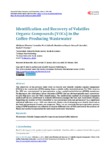Por favor, use este identificador para citar o enlazar este ítem:
http://www.alice.cnptia.embrapa.br/alice/handle/doc/986776Registro completo de metadatos
| Campo DC | Valor | Lengua/Idioma |
|---|---|---|
| dc.contributor.author | OLIVEIRA, A. | pt_BR |
| dc.contributor.author | CABRAL, L. M. C. | pt_BR |
| dc.contributor.author | BIZZO, H. R. | pt_BR |
| dc.contributor.author | ARRUDA, N. P. | pt_BR |
| dc.contributor.author | FREITAS, S. P. | pt_BR |
| dc.date.accessioned | 2014-05-22T11:11:11Z | pt_BR |
| dc.date.available | 2014-05-22T11:11:11Z | pt_BR |
| dc.date.created | 2014-05-22 | pt_BR |
| dc.date.issued | 2014 | pt_BR |
| dc.identifier.citation | Journal of Water Resource and Protection, v. 6, n. 4, p. 375-380, Mar. 2014. | pt_BR |
| dc.identifier.uri | http://www.alice.cnptia.embrapa.br/alice/handle/doc/986776 | pt_BR |
| dc.description | The objectives of the present study were to recover and identify volatiles organic compounds (VOCs) in the wastewater (WW) coming from a soluble coffee industrial plant. For VOCs recover, the WW was concentrated by pervaporation using a polydimethylsiloxane (PDMS) membrane. Furthermore, the solid phase micro extraction (SPME) and gas chromatography-mass spectrometry (GC-MS) were used for VOCs identification. The multivariate method of principal component analysis (PCA) was performed to evaluate differences amongst the feed and concentrate streams. Regarding the number of VOCs identified in the wastewater (33) and permeate (72), a significant statistical difference at p < 0.05 was observed. Clusters discriminating were clearly observed, as the feed and permeate streams are compared. Thus, we can conclude that pervaporation process using a PDMS membrane was effective to recover different class of VOCs present in the aqueous effluent and can be recommended for industrial wastewater treatment. | eng |
| dc.language.iso | eng | eng |
| dc.rights | openAccess | eng |
| dc.subject | Compostos voláteis | pt_BR |
| dc.subject | Pervaporação | pt_BR |
| dc.subject | Indústria do café solúvel | pt_BR |
| dc.subject | Coffee producing | pt_BR |
| dc.subject | Volatiles organic compounds | pt_BR |
| dc.title | Identification and recovery of volatiles organic compounds (VOCs) in the coffee-producing wastewater. | pt_BR |
| dc.type | Artigo de periódico | pt_BR |
| dc.date.updated | 2016-02-15T11:11:11Z | pt_BR |
| dc.subject.thesagro | Águas Residuais | pt_BR |
| dc.subject.nalthesaurus | wastewater | pt_BR |
| dc.description.notes | Na publicação: Humberto Bizzo. | eng |
| riaa.ainfo.id | 986776 | pt_BR |
| riaa.ainfo.lastupdate | 2016-02-15 | pt_BR |
| dc.identifier.doi | 10.4236/jwarp.2014.64039 | pt_BR |
| dc.contributor.institution | ALCILUCIA OLIVEIRA, UNIVERSIDADE FEDERAL DO RIO DE JANEIRO | pt_BR |
| dc.contributor.institution | LOURDES MARIA CORREA CABRAL, CTAA | eng |
| dc.contributor.institution | HUMBERTO RIBEIRO BIZZO, CTAA | eng |
| dc.contributor.institution | NEUSA P. ARRUDA, INSTITUTO FEDERAL DO RIO DE JANEIRO | eng |
| dc.contributor.institution | SUELY PEREIRA FREITAS, UNIVERSIDADE FEDERAL DO RIO DE JANEIRO. | eng |
| Aparece en las colecciones: | Artigo em periódico indexado (CTAA)  | |
Ficheros en este ítem:
| Fichero | Descripción | Tamaño | Formato | |
|---|---|---|---|---|
| 2014001.pdf | 895.78 kB | Adobe PDF |  Visualizar/Abrir |









